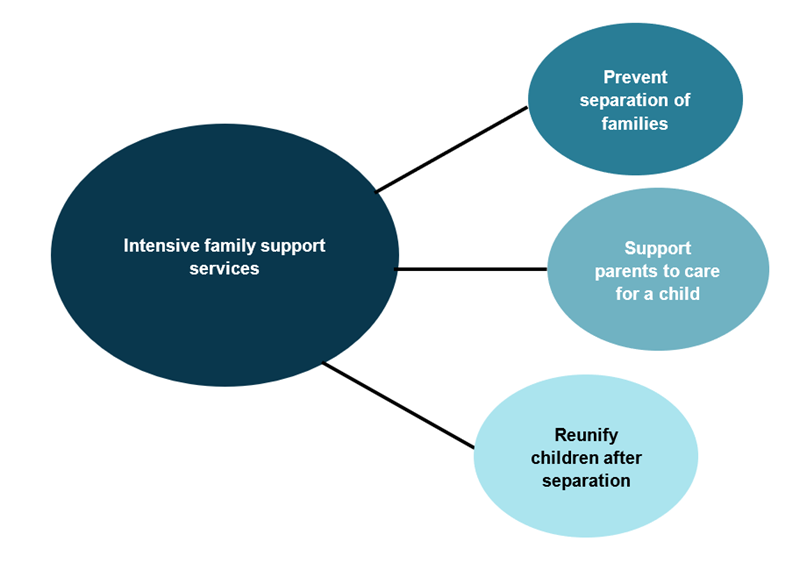Intensive family support services
Key findings
- In 2020–21, about 36,400 children aged less than 18 years commenced intensive family support services.
- For jurisdictions with available data, the majority (70%) of children were living with their parents when they commenced intensive family support services.
What is the role of intensive family support services?
Intensive family support services aim to provide support services to families with varying levels of involvement in the child protection system (Figure 8.1). Families may be referred to these services at any time once they have come into contact with the system.
Figure 8.1: Overview of intensive family support services

Chart: AIHW.
Box 8.1 describes the criteria for intensive family support services included in this report.
Box 8.1: Data notes for intensive family support services
To be included in the intensive family support services data reported here, outsourced intensive family support services must provide:
- services that explicitly aim to prevent separation or to reunify families
- a variety of services as part of an integrated strategy focusing on improving family functioning and skills, rather than just one type of service, such as emergency or respite care
- intensive services, averaging at least 4 hours of service per week for a specified short‑term period (usually less than 180 days).
Generally, referrals will come from the statutory agency, and will have been identified through the child protection process.
Currently, the national data collection is limited to intensive family support services, and does not include other types of family support services that do not meet these criteria.
How many children received intensive family support services?
In 2020–21, about 36,400 children aged less than 18 years commenced intensive family support services (Table 8.1). Of these, 21% were aged under 5.
The majority (70%) of children who commenced an intensive family support service were living with their parents (Supplementary table S8.1). Living arrangement data for intensive family support services excludes New South Wales, Queensland, South Australia and Tasmania.
Children commencing intensive family support services might also appear in the other child protection statistics presented throughout this report, but the extent of this overlap cannot currently be measured in the national data.
| State or territory | 0–4 | 5–9 | 10–14 | 15–17 | Unknown | Total |
|---|---|---|---|---|---|---|
| NSW | n.a. | n.a. | n.a. | n.a. | n.a. | 11,222 |
| Vic | 3,112 | 2,740 | 2,730 | 1,020 | 0 | 9,602 |
| Qld | 3,226 | 3,359 | 3,134 | 1,038 | 0 | 10,757 |
| WA | 589 | 463 | 356 | 99 | 19 | 1,526 |
| SA | 278 | 192 | 164 | 43 | 1 | 678 |
| Tas | 265 | 289 | 277 | 89 | 1,015 | 1,935 |
| ACT | 85 | 69 | 62 | 20 | 0 | 236 |
| NT | 185 | 115 | 127 | 33 | 0 | 460 |
| Total | 7,740 | 7,227 | 6,850 | 2,342 | 1,035 | 36,416 |
Note: for jurisdiction-specific footnotes, see Table 8.1 in the Child protection Australia 2020–21 data tables.
Source: AIHW Child Protection Collection 2020–21.
How many intensive family support services and providers are there in Australia?
In 2020–21, about 460 intensive family support service providers delivered services in Australia (excluding Northern Territory). Services were delivered across 465 locations (excluding Northern Territory) (unpublished data from the AIHW Child Protection Collection).


